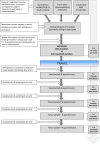The Carriage Of Multiresistant Bacteria After Travel (COMBAT) prospective cohort study: methodology and design
- PMID: 24775515
- PMCID: PMC4020574
- DOI: 10.1186/1471-2458-14-410
The Carriage Of Multiresistant Bacteria After Travel (COMBAT) prospective cohort study: methodology and design
Abstract
Background: Antimicrobial resistance (AMR) is one of the major threats to public health around the world. Besides the intense use and misuse of antimicrobial agents as the major force behind the increase in antimicrobial resistance, the exponential increase of international travel may also substantially contribute to the emergence and spread of AMR. However, knowledge on the extent to which international travel contributes to this is still limited. The Carriage Of Multiresistant Bacteria After Travel (COMBAT) study aims to 1. determine the acquisition rate of multiresistant Enterobacteriaceae during foreign travel 2. ascertain the duration of carriage of these micro-organisms 3. determine the transmission rate within households 4. identify risk factors for acquisition, persistence of carriage and transmission of multiresistant Enterobacteriaceae.
Methods/design: The COMBAT-study is a large-scale multicenter longitudinal cohort study among travellers (n = 2001) and their non-travelling household members (n = 215). Faecal samples are collected before and immediately after travel and 1 month after return from all participants. Follow-up faecal samples are collected 3, 6 and 12 months after return from travellers (and their non-travelling household members) who acquired multiresistant Enterobacteriaceae. Questionnaires are collected from all participants at each time-point. Faecal samples are screened phenotypically for the presence of extended-spectrum beta-lactamase (ESBL) or carbapenemase-producing Enterobacteriaceae. Positive post-travel isolates from travellers with negative pre-travel samples are genotypically analysed for ESBL and carbapenemase genes with microarray and gene sequencing.
Discussion: The design and scale of the COMBAT-study will enable us to provide much needed detailed insights into the risks and dynamics of introduction and spread of ESBL- and carbapenemase-producing Enterobacteriaceae by healthy travellers and the potential need and measures to monitor or manage these risks.
Trial registration: The study is registered at clinicaltrials.gov under accession number NCT01676974.
Figures



References
-
- Carattoli A. Plasmids and the spread of resistance. Int J Med Microbiol. 2013;303(6–7):298–304. - PubMed
Publication types
MeSH terms
Substances
Associated data
LinkOut - more resources
Full Text Sources
Other Literature Sources
Medical

